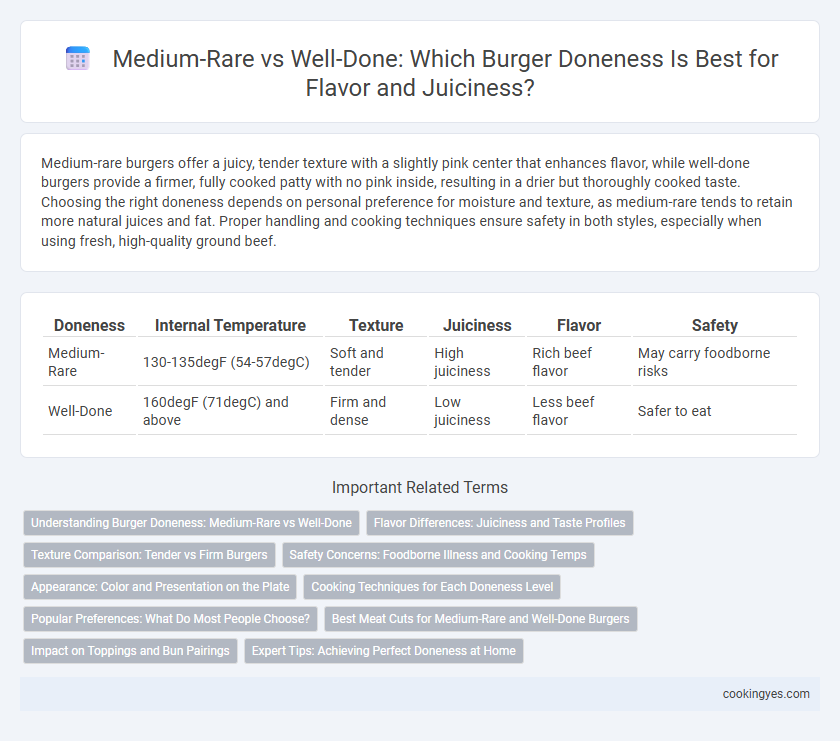Medium-rare burgers offer a juicy, tender texture with a slightly pink center that enhances flavor, while well-done burgers provide a firmer, fully cooked patty with no pink inside, resulting in a drier but thoroughly cooked taste. Choosing the right doneness depends on personal preference for moisture and texture, as medium-rare tends to retain more natural juices and fat. Proper handling and cooking techniques ensure safety in both styles, especially when using fresh, high-quality ground beef.
Table of Comparison
| Doneness | Internal Temperature | Texture | Juiciness | Flavor | Safety |
|---|---|---|---|---|---|
| Medium-Rare | 130-135degF (54-57degC) | Soft and tender | High juiciness | Rich beef flavor | May carry foodborne risks |
| Well-Done | 160degF (71degC) and above | Firm and dense | Low juiciness | Less beef flavor | Safer to eat |
Understanding Burger Doneness: Medium-Rare vs Well-Done
Medium-rare burgers offer a juicy, tender texture with a pink center, preserving the beef's natural flavors and moisture, which appeals to many gourmet enthusiasts. Well-done burgers, cooked thoroughly to an internal temperature of 160degF or higher, provide a firmer texture and reduced risk of foodborne illness, preferred by those seeking a fully cooked patty. Understanding the balance between flavor intensity and safety is crucial when choosing the ideal burger doneness.
Flavor Differences: Juiciness and Taste Profiles
Medium-rare burgers retain more natural juices, offering a tender texture with a rich, beefy flavor that highlights umami notes and subtle fat sweetness. Well-done burgers develop a firmer texture and a more caramelized, charred crust, enhancing smoky and savory flavors but often sacrificing juiciness. The choice between medium-rare and well-done significantly impacts the burger's taste profile and moisture retention, affecting overall flavor satisfaction.
Texture Comparison: Tender vs Firm Burgers
Medium-rare burgers offer a tender, juicy texture with a slightly pink center that enhances the beef's natural flavors. Well-done burgers have a firmer, denser texture due to thorough cooking, often resulting in less moisture and a more compact bite. Choosing between medium-rare and well-done affects the burger's mouthfeel and overall eating experience significantly.
Safety Concerns: Foodborne Illness and Cooking Temps
Cooking burgers to medium-rare, typically 130-135degF, poses higher risks of foodborne illness due to potential survival of harmful bacteria like E. coli and Salmonella. Well-done burgers, cooked to at least 160degF, ensure internal temperatures sufficient to kill pathogens, significantly reducing safety concerns. Proper temperature control during cooking is critical to prevent foodborne illness while balancing taste preferences.
Appearance: Color and Presentation on the Plate
Medium-rare burgers feature a warm pink center with a juicy texture, providing an appealing contrast against a well-seared brown crust that enhances visual appeal on the plate. Well-done burgers exhibit a uniformly brown interior, often drier, which can appear less vibrant but offers a consistent presentation suited for those preferring full doneness. The color gradient and moisture retention in medium-rare burgers create a more dynamic and appetizing appearance compared to the solid, darker tone of well-done patties.
Cooking Techniques for Each Doneness Level
Medium-rare burgers achieve juiciness and tenderness through quick searing at high heat, preserving pink centers with a deep brown crust formed by the Maillard reaction. Well-done burgers require longer cooking times over moderate heat to ensure thorough internal temperature reaches 160degF (71degC), often necessitating pressing or flipping to avoid dryness. Techniques such as using a meat thermometer for precise doneness and resting the patty post-cooking help retain moisture and flavor for both doneness levels.
Popular Preferences: What Do Most People Choose?
Most people prefer medium-rare burgers for their juiciness and rich, tender texture, which preserves the beef's natural flavors. Well-done burgers are favored by those who prioritize food safety and a firmer bite, resulting in a fully cooked patty with less pink. Surveys consistently show a higher preference for medium-rare, especially among burger enthusiasts seeking maximum flavor.
Best Meat Cuts for Medium-Rare and Well-Done Burgers
Prime cuts like chuck and brisket maintain juiciness and flavor when cooked medium-rare, offering a tender, juicy burger experience. Well-done burgers benefit from leaner cuts such as sirloin and round, which hold shape without excessive drying during longer cooking. Selecting the appropriate cut based on desired doneness ensures optimal texture and taste in every burger.
Impact on Toppings and Bun Pairings
Medium-rare burgers retain more juiciness and fat, enhancing the flavor absorption of fresh toppings like lettuce, tomato, and pickles while preventing the bun from becoming soggy. Well-done burgers have a firmer texture and less moisture, making them ideal for heartier toppings such as grilled onions or melted cheese that complement a toasted, sturdier bun. Choosing the right doneness level is crucial to maintaining the balance between burger juiciness, topping texture, and bun integrity for an optimal eating experience.
Expert Tips: Achieving Perfect Doneness at Home
Achieving perfect burger doneness at home requires precise temperature control, with medium-rare burgers ideally cooked to an internal temperature of 130-135degF, ensuring a juicy and tender center. For well-done burgers, aim for 160degF to eliminate any risk of harmful bacteria while maintaining moisture by using ground beef with a higher fat content or adding a small amount of water or broth. Resting the burger for a few minutes after cooking allows juices to redistribute, enhancing flavor and texture regardless of doneness preference.
Medium-Rare vs Well-Done for Burger Doneness Infographic

 cookingyes.com
cookingyes.com